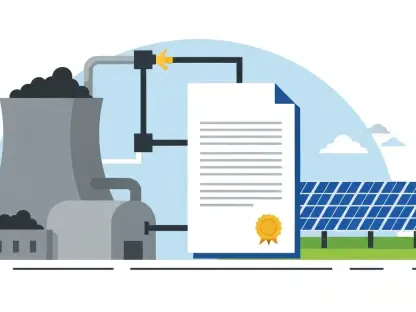Artificial intelligence (AI) has driven an exponential increase in data centers’ presence and energy demands. The growing need for data storage, processing, and management presents a significant challenge for the electric grid’s stability. As AI technology advances, it is crucial to strategize ways to manage its energy consumption to prevent overloading the grid.
The Growth of AI Data Centers
Rapid Expansion Across States
The proliferation of AI data centers is a nationwide phenomenon, affecting states from California to Virginia and Georgia. With data centers set to potentially triple their demand for electricity by 2028, fueling 12% of the nation’s total power consumption, proactive measures are urgent. States must find a balance to ensure AI’s growth does not destabilize the electric grid.
The dramatic increase in data centers linked to the AI boom has brought both opportunities and challenges to various states. As technology companies expand their infrastructure to support AI advancements, states are seeing a significant uptick in energy consumption. Georgia, for instance, has experienced a surge in new data center developments, prompting legislators to explore methods to manage the increasing power requirements effectively. Similarly, Virginia, a central hub for data centers, faces unprecedented growth, demanding an evaluation of its current power grid’s capacity and efficiency. This expansion underscores the need for forward-thinking strategies to ensure that while AI technologies advance, the electrical grid remains stable and consumer costs do not skyrocket.
Legislative Actions in Progress
State governments are working on new regulations to cope with the rising energy requirements. Strategies include compelling data center developers to finance their power needs significantly, preventing increased costs for everyday consumers. Policies also aim to push for sustainable power sources, ensuring that the energy required supports AI’s growth sustainably.
In California, lawmakers are considering regulations that could mandate data centers to shift towards more sustainable energy sources. By implementing policies that encourage renewable energy usage, California aims to balance the rapid growth of AI infrastructure with ecological considerations. Oregon, another state seeing a rise in AI data centers, contemplates requiring these facilities to either generate their energy sustainably or contribute significantly to the development of green power projects. These legislative actions demonstrate a broader effort to integrate sustainability into the burgeoning AI landscape, ensuring these innovations do not compromise the integrity of the power grid. The pressing objective across states is clear: growth in data centers must not mean unsustainable increases in energy consumption or costs for the average consumer.
Regulatory Responses and Industry Acceptance
Shifting Dynamics Between States and Tech Giants
Historically, states lured tech companies with generous incentives. Now, they demand that these giants assume more responsibility for their energy footprints. This shift emphasizes states’ acknowledgment of AI data centers’ substantial energy demands and the need for sustainable practices.
The evolving relationship between state governments and technology giants marks a significant shift in the industry’s landscape. Traditionally, states like Texas have offered tax breaks and other incentives to attract tech companies, positioning them as central hubs for data centers. However, the rising energy consumption from these facilities has led to a reassessment of these dynamics. States now advocate for policies where technology firms must actively contribute to managing their energy use. For example, though Texas still promotes favorable conditions for tech enterprises, it is simultaneously pushing for regulations that ensure data centers bear the costs linked to their energy consumption. This emerging regulatory framework underscores the recognition that while AI drives economic growth, its energy footprint necessitates responsible management.
Industry’s Role in Energy Management
There is a noticeable acceptance within the data center industry regarding the necessity for regulatory measures. Companies are willing to bear their fair share of service costs and are exploring innovative solutions, such as sourcing power from nuclear reactors, to reduce their impact on the electric grid.
Innovative approaches within the data center industry illustrate a proactive stance towards energy management. Data center operators are increasingly collaborating with state agencies and grid operators to develop solutions that harmonize their operational needs with the grid’s stability. Companies such as Google and Microsoft are investing heavily in renewable energy projects, committing to powering their data centers with wind and solar energy. Moreover, initiatives like direct power sourcing from nuclear reactors highlight the industry’s willingness to explore diverse energy solutions. This trend signifies a collective acknowledgment from tech giants about the critical need to mitigate their environmental impact. By embracing regulations that align with sustainable practices, the industry positions itself as a responsible stakeholder in the broader discussion on energy consumption and grid stability.
Addressing Power Demand Risks
Strain on Power Infrastructure
The rapid increase in AI data center operations poses significant risks to existing power infrastructure. Without responsive legislation, vital services could face disruptions. Examples like Texas’s efforts to legislate power usage reductions during emergencies highlight the urgency to safeguard against grid failures.
The strain on power infrastructure due to the proliferation of AI data centers is becoming increasingly evident. States are grappling with the dual challenge of accommodating the energy demands of AI technologies while maintaining grid reliability. During the winter storm in 2021, Texas experienced catastrophic power failures, underscoring the urgent need for legislation to manage energy consumption effectively. In light of such events, Texas lawmakers propose measures requiring data centers to reduce their power usage during peak demand periods, aiming to prevent grid overloads. These legislative initiatives are crucial as they seek to balance the technological advancements driven by AI with the practical need to ensure uninterrupted power supply to all consumers. This delicate balancing act underscores the complexity of integrating high-energy consumption facilities within existing power grids without compromising service stability.
Commitment to Sustainable Solutions
AI-focused industries are looking for ways to meet their vast energy needs responsibly. By committing to sustainable energy solutions, such as integrating more renewable energy sources into their operations, these centers can mitigate their environmental impact while promoting grid stability.
Tech companies are increasingly recognizing their role in fostering sustainable energy solutions to support their AI data centers. Amazon Web Services, for example, has committed to achieving 100% renewable energy usage for its data centers by 2025, investing in large-scale wind and solar projects globally. This commitment reflects a broader industry trend towards integrating renewable energy sources into data center operations, mitigating their environmental footprint. Furthermore, companies are exploring energy-efficient cooling technologies and AI-powered energy management systems to reduce overall power consumption. By prioritizing sustainability, the AI industry not only addresses its considerable energy demands but also contributes to a more resilient and stable power grid. These initiatives not only support environmental goals but also align with broader efforts to enhance the reliability of the electric grid in an era of rapid technological advancement.
Federal and State Perspectives
National Investments and Regulatory Challenges
On a national level, substantial investments in AI infrastructure signal its strategic importance. However, federal rollbacks on policies addressing AI’s energy impact create a complex regulatory environment. This juxtaposition underscores the need for alignment between national ambitions and state-level regulatory foresight.
The federal government’s investment in AI infrastructure reflects the technology’s strategic importance for future economic and technological developments. Significant funds are being funneled into developing AI capabilities, signaling a national commitment to leading in this cutting-edge field. However, this national priority exists alongside regulatory complexities, especially when federal policies roll back environmental safeguards that address AI’s energy consumption. This tension between promoting AI innovation and managing its energy impacts necessitates a nuanced approach. Whereas states like California are advancing stringent regulations to curb the energy use of AI data centers, federal policies under different administrations have varied, sometimes easing critical regulations. The scenario highlights the need for cohesive strategies that harmonize federal ambitions with state-level regulatory frameworks, ensuring AI’s growth does not compromise the electricity grid’s resilience.
Environmental Concerns under Different Administrations
The presence of data centers has exponentially increased due to advances in artificial intelligence (AI), leading to a surge in energy demands. This growing demand for data storage, processing, and management is posing a substantial challenge to the stability of the electric grid. As AI technology continues to evolve, the energy consumption associated with it must be managed to avoid overwhelming the grid.
Effective strategies need to be implemented to mitigate these energy demands. These strategies could include optimizing data center operations, improving the energy efficiency of AI algorithms, and investing in renewable energy sources. Additionally, advancements in cooling technologies and the development of more energy-efficient hardware will be crucial. Policymakers and industry leaders must collaborate to create standards and regulations that ensure the sustainable growth of AI technologies. By addressing these challenges proactively, we can ensure that the benefits of AI continue to be realized without jeopardizing the stability of our electric grid.









